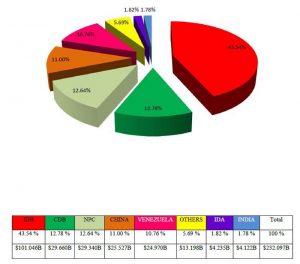October 23,2016 Source
Auditor General, Deodat Sharma, in his 2015 report, fixed Guyana’s external debt at US$1.16B. However, according to the Ministry of Finance, a debt management strategy developed under the APNU+AFC administration
has proven useful. The government has been able to reduce the figure to US $1.14B.
The Ministry’s half year report said that Guyana’s total public debt remained sustainable during the first half of 2016 as a result of a debt management strategy that is focused on ensuring that the government’s financing needs and payment obligations are met at a minimal cost.
According to the report, at the end of last June, Guyana’s total public debt amounted to just over US$1.552B, reflecting an increase of almost 1 percent compared to the 2015 half year position. Of the total public debt, external debt amounted to US$1.143B or 73.7 percent while domestic debt was $408.9M or 26.3 percent.
The report said that external public debt declined by 2.7 percent, from US$1.175B at the end of June 2015 to US$1.43B at end June 2016. This decline was mainly due to repayments of the oil debt to Venezuela in the form of rice and paddy shipments.
The report also stated that external principal and interest payments amount to US$27.1M during the first half of 2016, of which central government payments were US$24.5M.
Ministry of Finance said that compared with the previous year, total external debt service payments decreased by 46.9 percent. “This major reduction is a direct result of the decrease in debt service payments to Venezuela.
In July 2015, the PetroCaribe Arrangement and the Guyana -Venezuela Rice Trade Agreement (GVRTA) were halted.” This meant that there were no further shipments of rice and paddy to compensate for the oil debt to Venezuela. External disbursements significantly declined during the first half of 2016 in comparison to the same period last year.
At the end of June 2016, actual external disbursements total US$14.8M compared to US$51.0M at the end of June 2015. This 71 percent decrease was due to the abrupt halt of the PetroCaribe Arrangement, the completion of the Export -Import Bank of China E -Government Project and reduced disbursements from the multilateral creditors. In the first half of 2016, the multilateral creditors provided 86 percent of the external financing in comparison to 45 percent over the same period last year, while the bilateral creditors accounted for 14 percent of external disbursements at the end of June 2016 compared to 55 percent at the end of June 2015.
The report also noted that Guyana continues to accumulate significant arrears, totalling US$158.5 million at June 30, 2016, to its bilateral non-Paris Club and commercial creditors who did not participate in the Heavily Indebted Poor Countries (HIPC) Initiative.
The Government continues to actively engage these creditors with a view to debt write-offs. Some of these debts date back to the 1970s.

